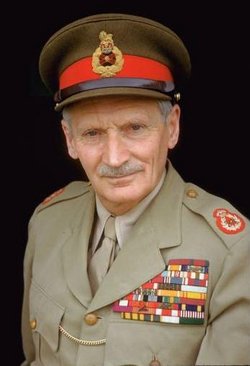
British army field marshal who was instrumental in the planning and execution of key engagements in North Africa and Europe. Whether considered a latter-day Marlborough or Wellington or “the most overrated general of World War II,” Bernard Law Montgomery remains the most controversial senior Allied commander of World War II. Montgomery was born in Kennington, London, on 17 November 1887. His father became the Anglican bishop of Tasmania, but the family returned to Britain when Montgomery was 13. He attended Saint Paul’s day school, Hammersmith, and entered the Royal Military Academy, Sandhurst, in 1907. The next year, Montgomery was commissioned into the Royal Warwickshire Regiment. Montgomery served in India, and in World War I, he fought on the Western Front and was wounded in the First Battle of Ypres in 1914. He was then posted to a training assignment in England but returned to the front to fight as a major in the 1916 Battle of the Somme. Montgomery ended the war as a division staff officer. Following occupation duty in Germany after the war, he graduated from the Staff College at Camberely in 1921 and returned there as an instructor five years later. In 1929, Montgomery rewrote the infantry training manual. He then served in the Middle East, commanded a regiment, and was chief instructor at the Quetta Staff College from 1934 to 1937. Between 1937 and 1938, he commanded 1st Brigade. He then took charge of the 3rd Infantry Division, which he led in France as part of the British Expeditionary Force after the start of World War II. He distinguished himself in the British retreat to Dunkerque in May and June 1940, and in July, he took charge of V Corps in Britain, protecting the English south coast.
His rise to fame began in 1942 when he was chosen by CHURCHILL to replace AUCHINLECK in command of 8th Army in the Western Desert. He had the good luck to take over at a time when the 8th Army was receiving its first plentiful consignment of modern equipment and reinforcements and when Rommel’s forces had almost outreached their own supplies by the speed and depth of their advance.
Montgomery rebuilt Eighth Army’s morale. Known for his concern for his men’s welfare, he was also deliberate as a commander. In the Battle of El Alamein in October and November 1942, his superior forces defeated and drove west German and Italian forces under Rommel.
It was Montgomery’s remarkable ability to infuse his new command with confidence and belief in his powers of command, as much as these material benefits, which fitted it, however, to undertake the task of defeating the enemy for good at the Battle of El Alamein. Montgomery’s conduct of the battle, and particularly of the pursuit towards Tunis which ensued, has been criticized. But he was the undoubted victor and thus, to that date, the first British general to have defeated a major German Commander in open battle.
The British people accepted him as a hero overnight and he never subsequently lost that cachet. After the landing of the Anglo-American armies in French North Africa he became subject to EISENHOWER’s command and fought successfully to destroy what remained of the German-Italian army in Africa, particularly at the Battle of Mareth.
Following the Axis surrender in the Battle of Tunis of May 1943, Montgomery played an active role in planning Operation HUSKY, the invasion of Sicily, and he led Eighth Army in the invasions of both Sicily in July and Italy in September.
In the invasion of Sicily he commanded in competition with the Americans for the capture of the island, and subsequently led the 8th Army in the invasion of Italy as far as the line of the River Sangro. In January 1944 he was recalled with Eisenhower to plan the invasion of Europe, in which he was to command the ground forces under the latter’s supreme direction. He rightly insisted on the amplification of the original landing force from three to five divisions and, once they were ashore on 6 June, conducted a well-judged offensive against the Germans which culminated in the breakout of the Allies from the bridgehead in July.
In September he surrendered control of the ground forces to Eisenhower, but continued in charge of the British 21st Army Group until the end of the war. During the Ardennes campaign, he was once again summoned by Eisenhower to take charge of an Anglo-American force on the northern flank of the break in, which he handled with great skill if less tact. His organization of the Rhine Crossing was his last major command achievement before the end of the war, when he accepted the surrender of all German forces in northern Europe. After the war he was Chief of the Imperial General Staff and Deputy Supreme Allied Commander in Europe. He had been made Viscount Montgomery of Alamein for his great victory of 1942.
Following the war, Montgomery commanded British occupation troops in Germany between May 1945 and June 1946. From 1946 to 1948, he was chief of the Imperial General Staff. He next served as chairman of the Western European commanders in chief from 1948 to 1951 and commander of North Atlantic Treaty Organization (NATO) forces in Europe and deputy supreme commander between 1951 and 1958. He retired in September 1958. A prolific writer, he personally drafted his memoirs that same year. Montgomery died at Isington Mill, Hampshire, England, on 24 March 1976.
References Baxter, Colin F. Field Marshal Bernard Law Montgomery, 1887-1976. Westport, CT: Greenwood Press, 1999. Chalfont, Alun. Montgomery of Alamein. New York: Atheneum, 1976. Hamilton, Nigel. Monty. 3 vols. New York: McGraw-Hill, 1981-1986. Lewin, Ronald. Montgomery as a Military Commander. New York: Stein and Day, 1972. Montgomery, Bernard L. The Memoirs of Field-Marshal the Viscount Montgomery of Alamein, K G. London: Collins, 1958.